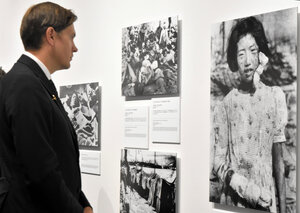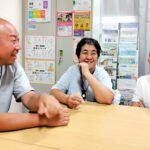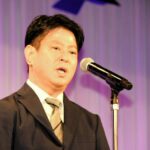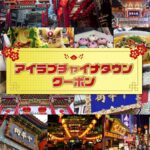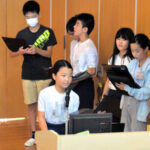Jørgen Watne Frydnes, chairman of the Nobel Committee, who is currently visiting Japan, inspected the photo exhibition “Hiroshima 1945: 80 Years After the Atomic Bombing” in Meguro on the 28th.
The exhibition features 162 archival photographs and two video recordings taken in Hiroshima immediately after the bombing, captured by photojournalists and photographers.
Frydnes inquired about how the photographs were used in media coverage. The director of the Hiroshima Peace Media Center explained that wartime media was under government and military control, and after Japan’s surrender, atomic bomb-related reporting was restricted by the GHQ.
After the inspection, Frydnes told reporters, “These photographs powerfully testify to the impact on people’s lives, their fate, and the future.”
Nobel Committee
The Nobel Committee is responsible for selecting the winners of the Nobel Prizes, which were established by Alfred Nobel’s will in 1895. Comprising five separate committees (one for each prize category), it operates under the Nobel Foundation and is composed of respected experts in fields like physics, chemistry, medicine, literature, and peace. The Peace Prize committee is uniquely based in Norway, while the others are in Sweden, reflecting Nobel’s original instructions.
Japan
Japan is an island nation in East Asia with a rich cultural heritage spanning thousands of years, known for its blend of ancient traditions and modern innovation. Historically, it was shaped by imperial rule, samurai culture, and periods of isolation before rapidly modernizing in the late 19th century. Today, Japan is famous for its historic sites like Kyoto’s temples, vibrant pop culture, and landmarks such as Mount Fuji.
Hiroshima 1945: 80 Years After the Atomic Bombing
“Hiroshima 1945: 80 Years After the Atomic Bombing” reflects on the tragic events of August 6, 1945, when the U.S. dropped the world’s first atomic bomb on Hiroshima, killing over 140,000 people and devastating the city. Eight decades later, Hiroshima stands as a symbol of peace and resilience, home to the Hiroshima Peace Memorial Park and Museum, which educate visitors about the horrors of nuclear warfare and advocate for global disarmament. The city’s recovery and continued message of hope highlight the importance of remembrance and a commitment to a peaceful future.
Meguro
Meguro is a district in Tokyo, Japan, known for its upscale residential areas, trendy shops, and the scenic Meguro River, which is famous for its cherry blossoms in spring. The name “Meguro” (meaning “black eyes”) originates from a legend about a black-eyed statue of the Buddhist goddess Benzaiten at the local Meguro Fudo temple, dating back to the Edo period. Today, it blends historical charm with modern attractions, including art galleries and cafes.
Hiroshima Peace Media Center
The **Hiroshima Peace Media Center** is a digital and multimedia initiative by the *Chugoku Shimbun* newspaper, dedicated to documenting and promoting peace through the memory of the atomic bombing of Hiroshima in 1945. It provides archives, survivor testimonies, and news on global disarmament efforts, serving as an educational resource to convey the horrors of nuclear weapons. The center emphasizes the city’s message of peace and the importance of remembering history to prevent future tragedies.
GHQ
“GHQ” typically refers to the **General Headquarters**, which was the main command center for the Allied Occupation of Japan after World War II (1945–1952). Located in Tokyo, it was led by General Douglas MacArthur and played a key role in implementing political, economic, and social reforms in postwar Japan. The term may also refer to military headquarters in other contexts, but its most notable historical association is with the Allied occupation.

